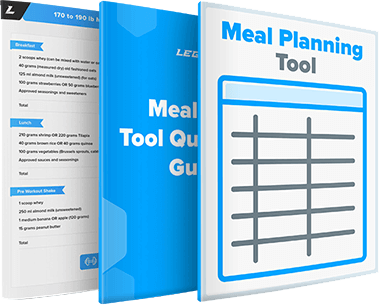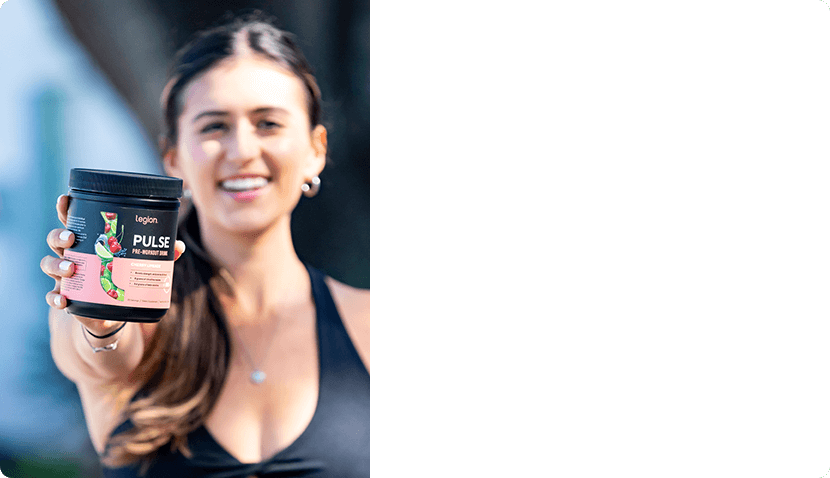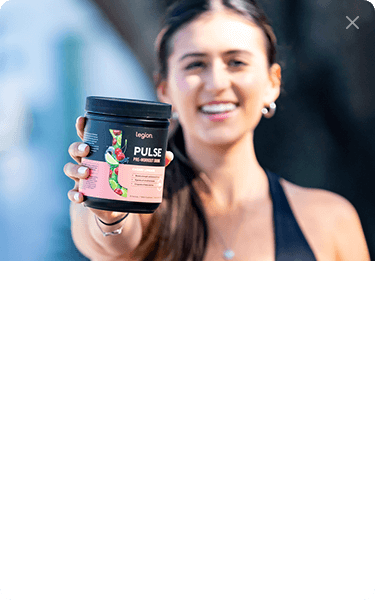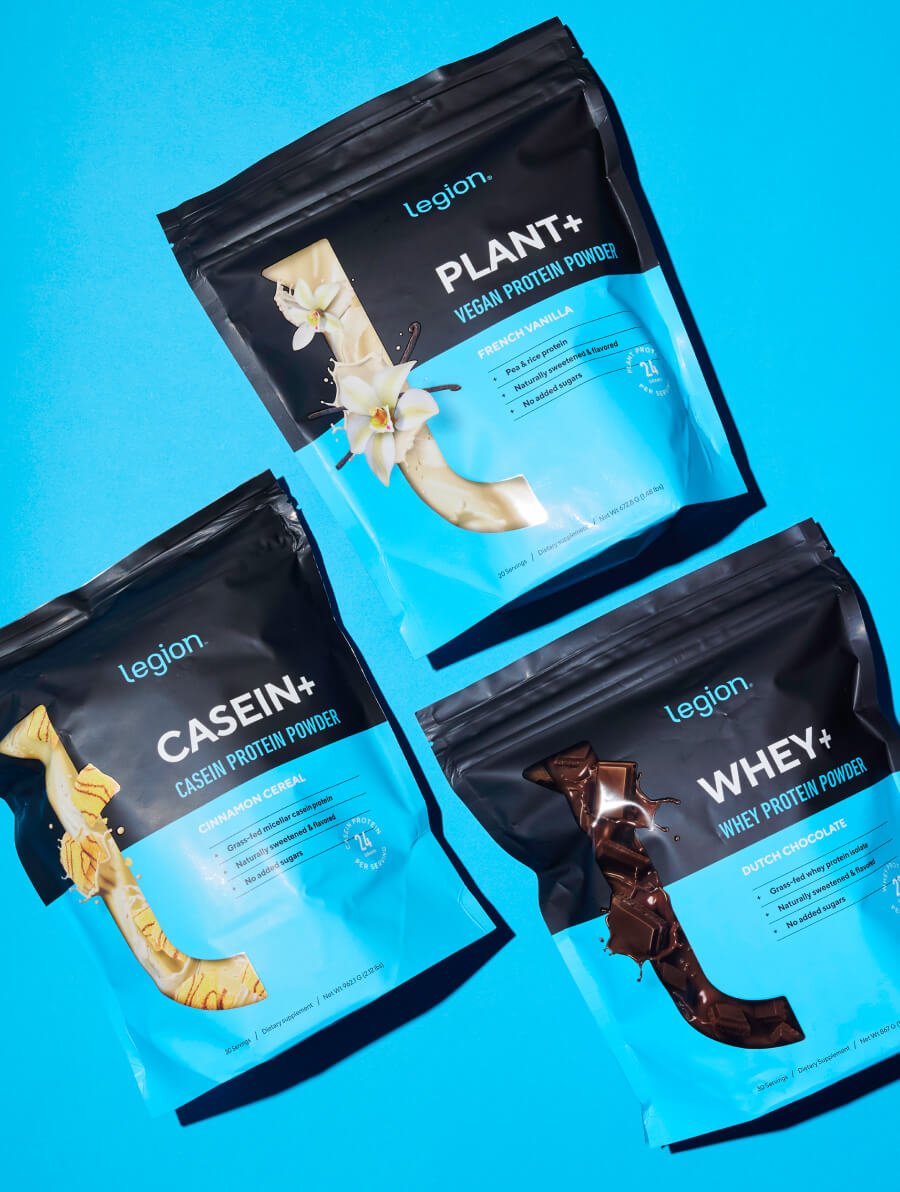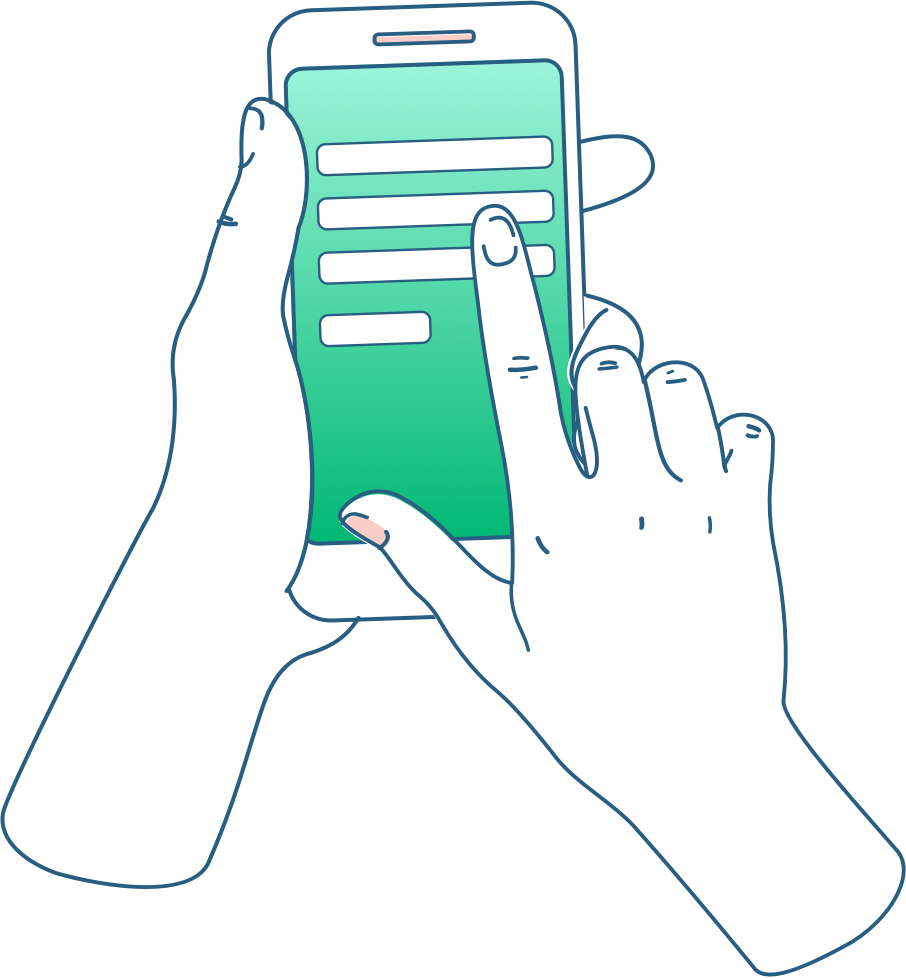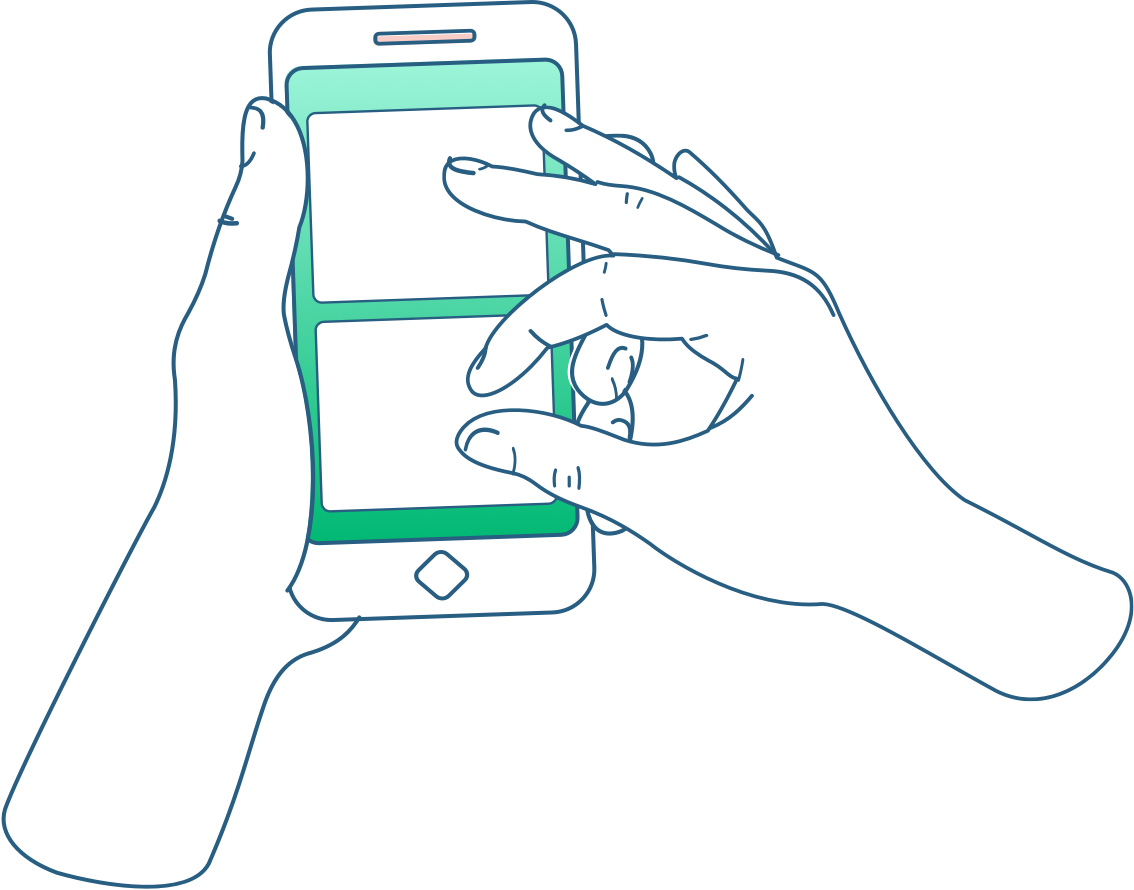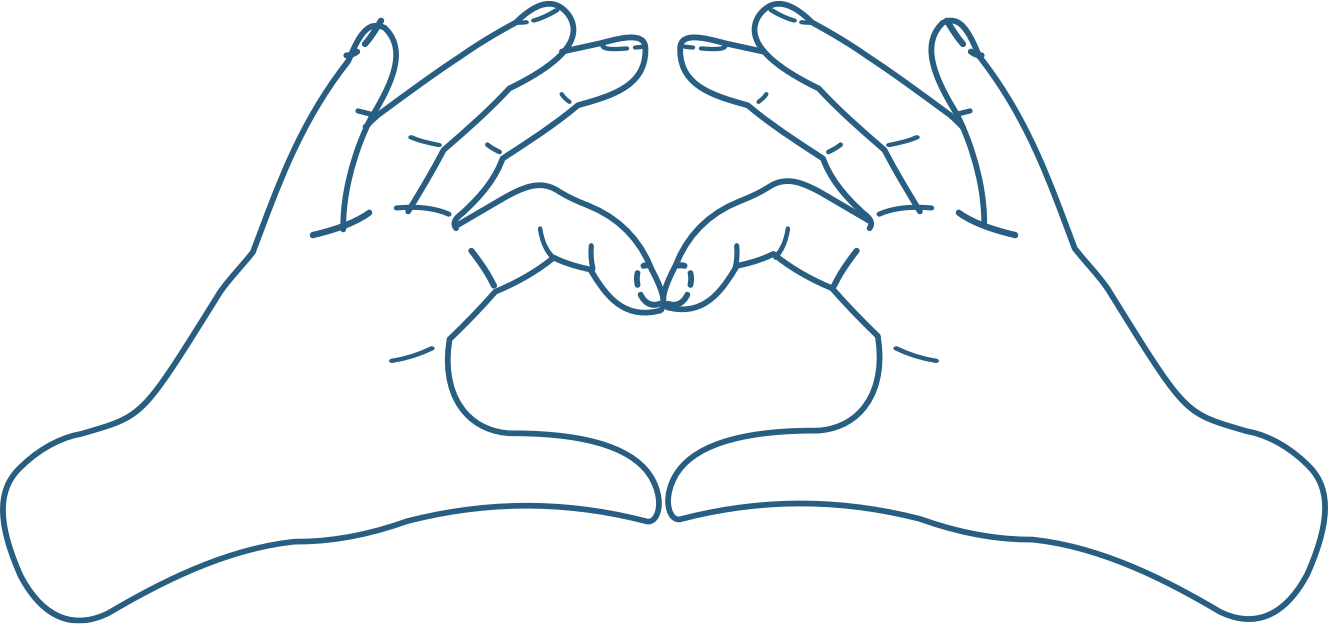Listen on Apple Podcasts | Listen on Spotify | Listen on YouTube
In this episode, I discuss strategies to beat bad eating habits, my favorite free-weight exercises for leg day, upcoming developments with Legion Clear Protein, and more.
As always, these questions come directly from my Instagram followers, who take advantage of my weekly Q&As in my stories.
If you have a question you’re dying to have answered, make sure you follow me on Instagram (@muscleforlifefitness) and look out for the Q&A posts. Your question might just make it into a podcast episode!
If you like this type of episode, let me know. Send me an email ([email protected]) or direct message me on Instagram. And if you don’t like it, let me know that too or how you think it could be better.
Timestamps:
(00:00) Intro
(02:03) Intermittent fasting—fad?
(06:33) Beat bad eating habits?
(10:39) Dream Whey+ flavor?
(11:25) TLS workouts—full coverage?
(11:52) Dexa scans reliable?
(12:50) Butter healthy?
(13:24) Best Adonis belt exercise?
(14:34) High urea—lower protein?
(14:54) Fastest way to first pull-up?
(15:21) Green powder worth it?
(16:00) Bicep tendonitis—alternatives?
(17:11) Biggest Legion challenge?
(26:03) Count all protein?
(29:03) Train on period?
(29:46) Raising what cows?
(30:47) Check nutrients without bloodwork?
(31:19) Compound vs. machines?
(34:47) 100g+ protein needed?
(36:01) Phosphatidic acid thoughts?
(37:16) Natural or enhanced?
(38:54) Best leg exercise no machines?
Mentioned on the Show:
The Little Black Book of Workout Motivation
Transcript:
[00:00:00] Hello, and welcome to another Q and A episode of Muscle for Life. I am your host. Thank you for joining me today to hear me answer a bunch of questions that people asked me over on Instagram. So every couple of weeks, I put up a story asking for questions. I get a bunch of questions. I go through them.
I choose ones that are interesting to me or topical—ones that I haven’t already answered a million times—and then I answer them briefly there on Instagram and bring everything over here on the podcast where I can expound on them further. And so in today’s episode, I am answering questions like the best way to beat bad eating habits for people who are training regularly, but just not hitting their calories and macros regularly or are just eating too much food regularly. What can you do?
I answer a couple of questions about Legion, some of the plans for this year, like, for example, Clear Whey Isolate, which is coming soon-ish from Legion in Q1 of this year. I [00:01:00] have a question here on DEXA scans for body fat percentage. How reliable are they really? And a question on butter. Is it a healthy fat source?
Should you be eating as much butter as you can possibly shove into your gullet or not? The quickest way to get to your first pull-up, and more. Before we get going with today’s episode, I need to tell you about my one-on-one coaching program, which might be for you if you are feeling like no matter what you do to eat better, no matter how much you work out, no matter what supplements you take, nothing seems to work.
And I know what that’s like. I’ve been there. It can be very frustrating. It can even make you feel a little bit crazy. You try, and you try, and you try, and then when those things don’t work, you try something else. You jump onto the new diet, the new workout plan, and then when you give your all to the newest things that don’t work, you finally [00:02:00] feel like giving up. Or maybe you can muster the will to keep the cycle going, but either way, you remain stuck. And this is how people can go to the gym for years, how they can eat well—at least well enough—they can take good supplements, and still look more or less the same as when they started.
And today, I’m going to give you the solution. I’m going to show you how to get unstuck and finally get out of that vicious cycle once and for all. And it starts with this: The biggest thing that I see with the people that we help is this—they are often missing just one crucial piece of the puzzle. And I bet it’s the same with you.
You are probably doing a lot of things right. However, there’s probably something you are not doing right that is giving you most of the grief. For example, maybe it’s your calories or macros. Maybe it’s your [00:03:00] exercise selection. Maybe it’s your food choices. Maybe you’re not progressively overloading your muscles. Whatever it is though, here’s what’s important: Once you identify what that one thing you’re missing is, once you figure it out, that’s when everything finally clicks—that’s when you start making serious progress. And this is exactly what my coaching team has done for over 3,000 men and women of all ages and abilities.
For example, they did it for Sarah, one of our clients who lost 21 pounds and six and a half inches off her waist in just 90 days. And in her words, “I’m in the best physical appearance of my life at age 45, and I have more energy and confidence. I feel like I found the secret to success.”
And we also did the same thing for another client, Andy, who cut 11 pounds of body fat and over four inches from his waist while also gaining over 50 pounds on his key lifts. He did those things also in just 90 days.
And in 90 days, we helped another client, Jen, slash four inches from her waist, add 30 pounds to her squat, and cut almost 15 pounds of body fat, all while eating foods she loved. And in her words, “rarely feeling hungry.”
Now, I could go on like that literally for hours, but in almost every success story, first and foremost, we helped our clients figure out that one thing that made all the difference for them. It’s kind of like typing in a password to log into your computer. You could have all the letters, numbers, symbols, and so forth, right—except one. And then what happens? You can’t log in, right? But as soon as you get that last remaining character right, voilà, you are in business.
And so, if I’ve learned anything from the thousands of success stories that we’ve racked up over the years, it’s this: You too are probably just one major shift, one important insight, one powerful new behavior away from Easy Street—or at least what feels like Easy Street compared to the street you’ve been stuck on.
And if you want some help figuring out what that one thing is—that one thing that’s missing for you—then my one-on-one coaching service might be for you. And of course, it could be a couple of things. It doesn’t have to just be one, and we don’t charge extra for that either.
And so, if you want to see if my coaching service is right for you, go to buylegion.com/coaching and schedule your free consultation call so my team can learn about you, your goals, your lifestyle, and then so the both of you can determine if the program is right for you.
And, by the way, there are people we speak with who are not a good fit for the program. That does [00:06:00] happen, but we almost always have other experts and other resources to refer them to. And then, if the program makes sense to you, you sign up, and you show up every day, you do the work, and then we guarantee your results or you get your money back.
So, again, if you are still listening to this and are even remotely interested in what I’ve said, don’t put this off for later and then forget. Take the first step now. Schedule your free consultation call over at buylegion.com/coaching.
C S H 1213 asks, “Best way to beat bad eating habits. I train, but the food is so hard to be consistent.”
I think the single best way to beat a bad diet is to simply eliminate the opportunities to eat the stuff that you eat too much of. Start there. You don’t have to stay there forever. This is similar to an elimination diet, right? Where you have someone who is [00:07:00] experiencing various negative reactions to foods that they’re eating and they don’t know which foods are causing the problems.
And so with an elimination diet, you often go to just meat because meat is well tolerated by most people. So you get rid of everything in your diet, and you just eat meat. And then you see how your body responds. Often the negative reactions disappear—not because meat has some magical property to it, but it’s just that you’ve gotten rid of whatever has been causing the problems.
But then the next phase of the elimination diet is you start reintroducing other foods one at a time and seeing how your body responds. And in that way, you isolate the exact foods that your body does not do well with.
So we can apply that mentality to junk food or sweets or other types of foods that people eat too much of that get in the way of them achieving their fitness goals. So you start by just eliminating that stuff. For most people, that means not stocking it at [00:08:00] home. That’s what is most important—just not buying the things that are getting in the way of your goals, the things that you are eating too much of.
That also generally means eating out less because the more you eat out, the more likely you are to just overeat—even if it’s accidentally—because you don’t understand how many calories are actually in those dishes. You don’t understand how many hidden calories there are in the way of butter and oil and sugar and cream and so forth.
So eating out less, and also reorganizing social events so they don’t involve eating or drinking. So that’s the place to start. And yes, it’s a bit extreme for some people, but you don’t have to stay there forever. You just start there and then you recalibrate there and then you start reintroducing things strategically, seeing how it impacts your success, seeing how it impacts your eating habits.
And what you may find, for example, is that there are certain foods that when you’re looking to control your calories, you simply should not have around. Ice cream is a good example of this. I can speak personally to this. I can’t eat 100 or 200 calories of ice cream and be satisfied. I mean, I can force myself, I can use discipline to just eat the 100 to 200 calories of ice cream and move on with my day, but I don’t find that very satisfying for the calories.
To get satisfaction from ice cream, I would say I need to eat at least half of a pint. So we’re talking five or six hundred, maybe even seven hundred, depending on what’s in it, calories of ice cream. That’s satisfying to me. And so I simply don’t keep ice cream around. I just don’t buy it.
And I’ve recently started messing around with the Ninja Creami, which so far I’m really enjoying because you can get a bit of the ice cream experience. It’s not exactly the same, of course, but you can get a bit of the ice cream experience using lower-calorie ingredients like almond milk and using protein powder for its sweetness and flavor for a lot fewer calories—maybe 200 or 300 calories in a pint, and there’s a bit of protein.
But anyway, coming back to ice cream, that’s something that I’ve learned to just not buy. Just don’t bother. And for my little indulgences, I much prefer dark chocolate. For example, I can eat 100 to 200 calories of dark chocolate and be satisfied. And so you’ll learn these quirks of your psychology, physiology, maybe a bit of both by doing this kind of elimination routine.
DanievDB7 asks, “What is a dream flavor of whey plus that you wish could exist tomorrow?”
New jerk response, honey-drizzled cornbread. I actually want to see if that’s possible. It may not be possible to get right, especially with natural ingredients, but I’m going to look into it.
And I have another question here from DanievDB7, “Would Legion ever look into these clear protein powders?”
Absolutely. We have one on the way. I don’t remember exactly when it’s coming out. It’s Q1 this year. I want to say February, maybe March. And we have one or two flavors initially, and we are going to aggressively expand our offering. We’re gonna push hard on new flavors. So, yeah, excited for that.
Dr. CK Tom asks, “Do your TLS workouts hit all muscle groups twice or more each week?”
Uh, so TLS is Thinner Leaner Stronger, by the way. My book, specifically a fitness book for women. And there are several programs with the book—three, four, and five-day programs. So the four and five-day programs train all major muscle groups two to three times per week. And the three-day programs hit them one to two times per week.
German Rosales asks, “How reliable are DEXA scans? Big difference in body fat percentage between DEXA and calipers.”
Well, despite the common belief that DEXA is absolutely infallible, it actually can be just as inaccurate as anything else if the machine isn’t calibrated properly. And this has been shown in a number of studies—it’s not just my opinion. DEXA can also over- or underestimate your body fatness based on physiological factors like hydration and others.
If you want to learn more about body fat percentage, calculating it, what it is, and what it is not, head over to legionathletics.com. Search for body fat percentage, and you can find a number of articles that I’ve written on the topic, like how to measure your body fat percentage using calipers, what a healthy body fat percentage is for men and women, and more.
Jan Corn asks, “Why is butter a healthy fat source when the primary fatty acid is palmitic acid?”
Sadly, butter is a uniquely unhealthy source of fat because of its special association with elevated total and LDL cholesterol levels. This has been shown in a number of studies—large body of evidence. Now, that’s not to say that you should avoid butter like you should avoid cigarettes, but it is to say that you shouldn’t eat a lot of it. It should not be a primary source of fat in your diet.
Javier de Haro asks, “What exercises make the cum gutters pop more?”
And I now know what cum gutters are. Had not heard that one before. That is also called the Adonis belt, you know, the V-shaped muscles that go from the man’s hips to his pee pee.
The answer is, one, you gotta get lean. That’s more important, actually, than doing any specific exercises. And then two, if you do heavy compound lifts that engage the core, like the squat, the deadlift, the overhead press, that is going to train those muscles in addition to many other muscles.
And then, if you need to, you can supplement with some core-specific training, like, for example, the hanging leg raise or the bicycle crunch—two simple exercises that you can even superset together. As you get stronger on the hanging leg raise, you can add weight by just snatching a dumbbell in between your feet. But many guys find that they don’t even need to do that. Once they get strong on the basic lifts and then get lean, they have great cum gutters.
Jay Bacchus 79 asks, “If your urea nitrogen level is high, should you drop protein per pound?”
No. So a high-protein diet increases urea nitrogen production due to the metabolism of excess amino acids. That’s normal. That’s expected. So that’s definitely not a reason to eat less protein.
JT Gan 1985 asks, “What’s the quickest way to get to your first pull-up?”
A few sets to failure per week of the following exercises: the lat pulldown, the negative pull-up, and the assisted pull-up. So that could be band-assisted or machine-assisted. And also lose weight if you are overweight. Work on those things, and before you know it, you’ll be doing pull-ups.
Kapil asks, “Should I eat greens powder if I’ve only sweet potato and cucumber and not enough veggies in my lean bulk diet?”
No, I think it’s better to just buy some raw spinach and eat a large handful every day—not even as a salad, just like a cow. Just slam it into your face, force yourself to eat the handful. I mean, it’s just a handful of spinach—simple. Spinach is awesome, super nutritious. I think it’s the best single vegetable to eat. Not that you should only eat one vegetable, but if I had to choose just one, it would be spinach.
Another question from Kapil: “I have minor biceps tendinitis. I can’t do biceps curls. Any alternative exercises?”
Well, really any type of curl or row that doesn’t aggravate the tendinitis, and to be specific, that doesn’t cause pain or discomfort that you would rate any more than maybe a two or three out of ten.
And if nothing works—if every type of curl that you can find, every type of row that you can find causes too much aggravation—then you need to rest the injured limb. That means no curling, no rowing, if rowing is also a problem for that limb. But keep training the healthy limb.
And I know that may sound a little bit counterintuitive. However, research shows that it will help maintain the muscle and strength in the injured limb. It’s called the crossover effect if you want to look into it. So, you keep training the healthy limb, you let the injured limb heal up, and then you get back to training the injured limb when you can do, again, some type of curl, some type of row with minimal pain, minimal aggravation.
Kimball Jensen asks, “What is the number one challenge in Legion Athletics right now?”
Currently, the number one challenge is probably just not having enough of the right people to make the most of the growth opportunities that we have. And that’s not a knock on anyone working at Legion. We have a lot of great people, but we just don’t have enough people to pursue the many growth opportunities that are in front of us.
Like retail, for example—we’re just getting started in retail, which really is a mistake. And that’s on me, 100 percent my fault that we got the e-commerce business to almost 50 million a year in revenue without pursuing retail at all.
That’s never a good playbook. Typically in CPG, what you do is use e-commerce to prove your product-market fit, to prove that your value proposition resonates with buyers, to prove that your business can scale. And then you use that as a business case to bring it to retail.
To put a specific number on it, you probably have a good business case at 5 million in trailing 12-month sales, and you can take that and then get into retail. Often retail can scale faster than e-commerce. But let’s say you’re very good at e-commerce, and so then you can scale e-commerce and retail at about the same rate.
And something I didn’t know years ago that I know now is that retail revenue is often viewed as more valuable—in the case of a strategic partner or a strategic buyer, even. Retail revenue is often valued higher than e-commerce revenue. That has to do with distribution, it has to do with controlling shelf space.
If you only stick to e-commerce, you can expect lower valuations. You can expect lower multiples on the business than if you have a healthy mix. Often, you’re going to want probably 30 to 50 percent of your revenue to come from retail, if not more, depending on the business.
If you’re strong in e-commerce, then ideally, you want to be strong in retail, where probably a 50/50 mix justifies a significant premium on the valuation of the business.
In fact, if you generate enough retail revenue, then the valuation becomes more of a multiple of revenue than a multiple of EBITDA. If you stick to just e-commerce, you’re almost certainly looking at a multiple of EBITDA unless you have explosive growth or some other unique factors that justify the premium that comes with being valued on a multiple of revenue.
So anyway, my mistake, I guess, is now a big opportunity. Well, I mean, it is—so I’m not trying to cope—but at least there is a silver lining in that Legion is more than primed to succeed in retail. We’ve gotten our e-commerce business to probably about 10 times what you would normally do before going into retail.
Of course, with that comes a lot of brand awareness and brand equity. Retail needs to be executed properly. Of course, it could go badly if it weren’t done well, but if it’s done well, it should go quite well for us.
Another example of a big growth opportunity for Legion that really should have been pursued a long time ago is international—both e-commerce and retail. When you take the international market or markets collectively, it represents actually more potential revenue than domestic, for me, the United States.
We’re really just getting started there as well. Again, I would call that a mistake, and it ultimately comes back on me. The primary reasons those mistakes were made were just strategic oversight, strategic tunnel vision—getting too focused on what we have been doing, what we have been good at, which is e-commerce—and not fully appreciating what retail can really do for the business and what international can really do for the business.
And then it comes back to this point of people. It is difficult to find people who are true experts at retail, who can make retail happen in a big way—not just sell into some mom-and-pop shops here and there, maybe some independent chains. No, build a program that’s going to produce 50 million in annual revenue. A retail program that can produce 50 million in annual revenue in, call it, three to five years at most.
Those people are out there, but they’re not easy to find. It takes quite a bit of work to do that. And it’s not that I am work-shy or that anybody that works with me is work-shy, but it’s not as easy as just sending some messages on LinkedIn and fielding some resumes and hiring the perfect candidate.
So anyway, my team and I are working to resolve this this year. We’ve already been working at this and hiring key people. There are a few other key hires that we’re going to be making this year to allow us to really capitalize on the opportunities that we have in front of us.
We will resume today’s episode shortly, but first, I need to tell you about my best-selling fitness mindset manual for breaking through mental resistance and barriers, building unshakable discipline, and keeping your goals alive when things get tough.
It’s called The Little Black Book of Workout Motivation. While fitness is not everything, everything is harder if you aren’t fit. The muscle and strength that you gain from working out is less important than the person you become by working out.
You become a person who understands that growing into the best version of themselves necessarily includes getting into great shape. You become a person who never underestimates the power of simply believing in themselves and always looks for reasons to bet on their hand. You become a person who realizes that they can achieve far more than they thought they were capable of.
That’s why I wrote The Little Black Book of Workout Motivation—to help you become that person by sharing insights from scientific research, compelling stories, and practical strategies for staying motivated when setbacks, failure, and self-doubt make you want to give up.
Here’s a sneak peek of what you’ll find inside The Little Black Book of Workout Motivation:
- The what, when, where, if, then formula that will rewire your thinking for more consistency inside and outside of the gym.
- Three simple questions that will reveal your true why for fitness and unlock a wellspring of motivation that will keep you going even when it’s hard.
- How to stop sabotaging your personal growth habits with complaining and negativity and how to develop a solution-oriented mindset that will empower you to take action and keep taking action.
- Warren Buffett’s two-list strategy for prioritizing your goals, eliminating distractions, and achieving a laser focus and maximum productivity.
- How to use productive pessimism to avoid what scientists call the positivity paradox and cultivate a balanced mindset that will turn self-doubt into self-belief.
And much more.
The bottom line is this: Getting fit is like doing anything that most people fail at. It is harder than you think it will be. It will take longer than you think it will take. You will make way more mistakes than you want to make.
But there’s also this: You can’t fail unless you give up.
If you’re feeling overwhelmed in your fitness, struggling with laziness, procrastination, or self-doubt—if you’re trying to reignite your passion for working out, and you’d like some strategies for developing a resilient mindset that will empower you to stick with your fitness for the long haul—then head over to Amazon now and pick up a copy of The Little Black Book of Workout Motivation and enjoy.
Mario Hugon asks, “Daily protein intake—would you recommend to count all types of protein sources, bread, pasta, etc.?”
Yes. However, ideally, you would get most of your protein from the best sources—the ones that are well absorbed, rich in essential amino acids, and then top off your protein intake with the lower-quality sources. That would be a lot of the residual protein in random foods.
So again, most of your protein should come from various animal products, like dairy and different types of meat. Seafood is great, and there are some good plant-based protein sources as well.
Practically speaking, what most people do is get most of their protein from protein powders—often whey or casein—and supplement it with plant proteins.
Megan Rudis asks, “Is intermittent fasting a fad or is it effective?”
Well, it’s actually both. It’s a fad when you view it in the context of many of the claims that are made to sell it—most of those claims are false. However, it is effective when viewed in the context of controlling your food intake. Some people find it easier and more enjoyable to hit their calories and macros with intermittent fasting.
For many people, it’s just skipping breakfast. They stop eating around dinner or maybe slightly after—6 p.m., 7 p.m., 8 p.m.—then skip breakfast and start eating again at lunch the next day, around 12 p.m. or 1 p.m. Many people find that approach better for controlling their calories, controlling their macros, feeling full, and enjoying their diet compared to frequent eating or forcing themselves to eat breakfast.
But there are also people who enjoy breakfast and actually do best with a large breakfast, making it the biggest meal of the day and tapering calories down as the day goes on. It’s just important to do what works best for you with meal frequency—you really can’t go wrong.
Now, if you’re a natural bodybuilder trying to get as jacked as possible, I wouldn’t recommend intermittent fasting. I would recommend more frequent feedings of protein. I definitely wouldn’t recommend something like OMAD (one meal a day) because that’s even worse for muscle gain.
If you’re not a natural bodybuilder and you’re just trying to get into great shape and stay there, don’t worry about meal frequency. Eat as many meals per day as suits your appetite and lifestyle. Just make sure you get enough protein by the end of every day. You don’t have to space it out perfectly—just hit your daily target.
Myra Bichet asks, “Is it right to train when I have my period, or should I pause training for 5-7 days?”
You can train. If you find that your performance is fine and you feel good, you don’t have to change anything. But if your performance noticeably declines and your workouts aren’t going well, simply modify your regimen.
You don’t have to skip workouts entirely. You can make them easier. If it’s so bad that even easier workouts are tough, then it’s fine to skip them altogether and come back when you’re feeling better.
Miss Danny Ryan asks, “What kind of cows did you mention you want to raise on your new property?”
She’s referring to a house I have under construction that’s finally going to be done. I’m told I should be in it by March—although they say February, and I don’t believe them, so I’m thinking March or April.
There’s a bit of land—it’s a farm—and I’ve thought about putting some animals on it. There are already horses, but maybe some other animals too. As far as cows go, I haven’t looked into it yet. I want to get on the property before I bother wasting my time getting my hopes up.
But my wife found these little miniature cows, of course, to go with her equally impractical and decorative silky chickens that she wants—form over function, always. I mean, I’m open to it. The cows are pretty cute, so we’ll see when we get on the farm.
Permadog22 asks, “Is there a less invasive way than blood work to check your nutrient levels?”
Unfortunately, no. That’s what you need to do if you really want to know. However, if you’ve never had it done, it’s a non-issue. It’s mildly annoying at most.
If the person doing it knows what they’re doing, you won’t even feel the needle going in. You’ll feel it a little bit when they swap vials, and you might have a little bruise after—that’s it.
Read Ali asks, “Reducing compound movements versus machines to limit fatigue—thoughts?”
Yes, this is actually an effective way to help manage fatigue, especially when you move from barbell work to machine work. That can be appropriate—it can even be optimal—depending on your circumstances and goals.
For example, if you’re an advanced weightlifter who has gained a lot of muscle and strength and you’re trying to squeeze out the last 20 percent of your potential, it might be appropriate to do less barbell squatting and more machine work.
I’ve experienced this firsthand over the last year. I’ve done a lot less barbell squatting and a lot more power squatting on machines like the V-hack squat, pivot press, and pendulum squat. I’ve made good progress with those machines.
I’ve noticed a significant improvement in the size and definition of my quads relative to my training experience and genetics. One of the reasons for that is those machines are less systemically fatiguing than a barbell squat.
Once you get fairly strong with the barbell squat, you’ll probably find that your back becomes a limiting factor before your quads do. You could push your quads a bit more, but eventually, your back just can’t take it. That doesn’t mean the barbell squat is a bad exercise—it’s just more of a whole-body exercise compared to machines like the power squat or pendulum squat, which are more quad-focused.
You could argue that those machines aren’t true isolation exercises like the leg extension, but they still isolate the quads far more than a barbell back squat or front squat. I’ve stuck with those machines because I’ve made good progress, and it’s been nice to see that development.
Even though I wasn’t explicitly trying to make my legs bigger, they’ve grown to the point where some of my jeans aren’t fitting quite right anymore—they’re starting to look like leggings. Some of my dress pants will probably need to be tailored again.
But I like training, and I like making progress, so I’m doing it anyway. That’s just an example of when it might be appropriate to shift some of your training volume for a specific muscle group from free-weight compound movements to machines.
The Real Stevie J1 asks, “Is more than 100 grams of protein daily really necessary for fat loss? I struggle getting more.”
For women, no—100 grams of protein per day is fine regardless of size. For men, though, that’s often going to be low unless we’re talking about a smaller man, like someone shorter who probably shouldn’t weigh more than 150 to 175 pounds. Even then, I’d prefer to see a bit more protein.
If we’re talking about a healthy body composition for a man—adding some muscle and bringing body fat down to around 15 percent—that man should probably weigh 180 pounds or more. In that case, 100 grams of protein per day is not going to be optimal.
That person will get better results with more protein. Bumping up to 150 grams per day would make a big difference. Bumping it up to 200 grams would make less of a difference, but it could still be worth it depending on the person’s goals.
Tim Sanchez 51 asks, “What are your thoughts on phosphatidic acid?”
Phosphatidic acid is often sold as a muscle-growth enhancer. I wish I could get behind the research that’s used to support it because I’d put it in a product at Legion. Unfortunately, the evidence just doesn’t support the claims.
Out of six studies that I’ve reviewed, three found no significant effects, and three showed improvements. However, one of those studies was confounded by other anabolic substances. When you look at the weight of the evidence, it just doesn’t justify the hype.
I don’t want to stick something like that in a product and make claims based on cherry-picking the two positive studies while ignoring the three that found nothing. That’s not how I like to do business. I’d consider that lying for a living, and I refuse to lie for a living.
You can try it if you want because there is some evidence of efficacy—it may work for certain people under certain circumstances. It’s not going to hurt, but I wouldn’t expect the type of results that are often promised to sell it.
Yuli Chesua asks, “Is your body naturally built, or have you used any enhancements?”
I’ve never used anabolic or cutting drugs. I have used ephedrine, though. I don’t know if you’d consider that a cutting drug, but I tried it when I was around my mid-twenties during a cut. I noticed a bit more metabolic activity, but it didn’t make a huge difference.
That’s it as far as artificial chemicals go. I did get my blood work done recently, and my total testosterone was in the 700s. I plan to stay natty for as long as I can. I think it’s very possible to maintain healthy hormones for another 20-plus years, and that’s the plan.
At some point, if my testosterone is clinically low, and I’ve done everything I can naturally to bring it up, and my quality of life is negatively impacted, then I would consider hormone replacement therapy.
Living with clinically low testosterone is not only physiologically unhealthy—it raises the risk of various diseases—it’s also psychologically unhealthy for men. It messes with your quality of life. For those reasons, I’d go on HRT if it came to that, understanding that I’d be on it for the rest of my life.
Wimbo asks, “Favorite leg exercises when machines are not available?”
The back squat, front squat, lunges—any type of lunge—the Bulgarian split squat, and the Nordic curl. Honestly, you don’t need anything else to get great legs.
If you’re a bodybuilder or trying to approach your training like a bodybuilder, aiming to get your legs as jacked as possible, you’ll eventually want to incorporate some other exercises, like isolation work and machine exercises for your quads. But if your goal is just to get strong and muscular without going full bodybuilder mode, those basics will get you there.
Before we close out today’s episode, I need to tell you about the protein powder that I use every day. It’s called Whey Plus, and it’s from my sports nutrition company, Legion.
Whey Plus is a naturally sweetened and flavored 100% whey isolate protein powder made with antibiotic- and hormone-free, truly grass-fed milk from Ireland. It’s gentle on your stomach, easy to digest, and doesn’t cause bloating or discomfort.
Whey Plus contains 22 grams of protein per serving, with 12 grams of essential amino acids and 5.5 grams of BCAAs. It contains no artificial sweeteners, flavors, food dyes, fillers, or other unnecessary junk—and no lactose or added sugars.
And I know the Irish dairy part might sound like marketing puffery, but did you know that research shows Ireland produces some of the healthiest and cleanest milk in the world? For example, Irish dairy cows graze for an average of 240 days per year, eating a diet that is 90% grass.
That pasture-based system results in great milk—healthier milk with more protein, beneficial unsaturated fatty acids, omega-3s, and vitamins like E, beta-carotene, and biotin.
Higher-quality, healthier milk means higher-quality, healthier whey made from that milk. That’s why Legion has sold over 1 million bags of Whey Plus, and it’s received over 9,000 five-star reviews from verified buyers on Amazon and Legion’s website.
Right now, you can save 20% on your first order of Whey Plus and anything else you might want to buy in Legion’s store by going to buylegion.com/whey and using the coupon code MUSCLE at checkout.
And if, heaven forbid, you don’t like Whey Plus or anything else you buy from us, just let us know, and we’ll give you your money back. You don’t even have to send the products back to us.
So again, go to buylegion.com/whey, try Whey Plus risk-free, and see for yourself why it’s one of the most popular truly grass-fed whey protein powders in the world. And don’t forget to use that coupon code MUSCLE to save 20% on your first order.
Well, I hope you liked this episode. I hope you found it helpful. If you did, subscribe to the show because it ensures you won’t miss new episodes, and it also helps me. It increases the show’s rankings, making it easier for other people to find it.
If you didn’t like something about this episode or the show in general, or if you have ideas or suggestions or just feedback to share, shoot me an email at [email protected]—and let me know what I can do better or just what your thoughts are on what you’d like to see me do in the future.
I read everything myself. I’m always looking for new ideas and constructive feedback. So thanks again for listening, and I hope to hear from you soon.
